

Question 6: Which of these aren't a style of kimono? Question 5: What are the traditionnal accessories for a women's kimono? Question 4: What is the simplified version of a kimono? Question 3: How many style of kimono are for men? Question 2: What is the kimono that is only for a married women? Question 1: What is the traditionnal costume of Japan? Kimono. Not to be confused with Kemono.
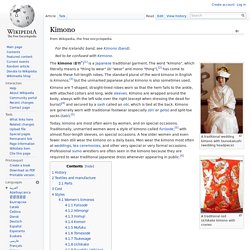
A traditional wedding kimono with tsunokakushi (wedding headpiece) A traditional red Uchikake kimono with cranes The kimono (着物?) [1] is a Japanese traditional garment. The word "kimono", which literally means a "thing to wear" (ki "wear" and mono "thing"),[2] has come to denote these full-length robes. Today, kimono are most often worn by women, and on special occasions. History[edit] As the kimono has another name, gofuku (呉服? Textiles and manufacture[edit] Kimonos for men should fall approximately to the ankle without tucking.
Kimonos are traditionally made from a single bolt of fabric called a tan. The maximum width of the sleeve is dictated by the width of the fabric. Traditionally, kimonos are sewn by hand; even machine-made kimonos require substantial hand-stitching. Hausa people. Most Hausa, however, live in small villages or towns in West Africa, where they grow crops, raise livestock including cattle and engage in trade.

They speak the Hausa language, an Afro-Asiatic language of the Chadic group. The Hausa aristocracy had historically developed an equestrian based culture.[3] Still a status symbol of the traditional nobility in Hausa society, the horse still features in the Eid day celebrations, known as Ranar Sallah (in English: the Day of the Prayer).[4] History and culture[edit] Hanbok. Hanbok (South Korea) or Chosŏn-ot (North Korea) is the traditional Korean dress.
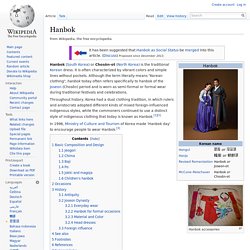
It is often characterized by vibrant colors and simple lines without pockets. Although the term literally means "Korean clothing", hanbok today often refers specifically to hanbok of the Joseon (Chosŏn) period and is worn as semi-formal or formal wear during traditional festivals and celebrations. Throughout history, Korea had a dual clothing tradition, in which rulers and aristocrats adopted different kinds of mixed foreign-influenced indigenous styles, while the commoners continued to use a distinct style of indigenous clothing that today is known as Hanbok.[1][2] Basic Composition and Design[edit]
Ao dai. The áo dài is a Vietnamese national costume, now most commonly worn by women.
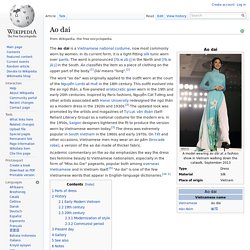
In its current form, it is a tight-fitting silk tunic worn over pants. Yukata. How to Put on a Women's Yukata Traditionally yukata were mostly made of indigo-dyed cotton but today a wide variety of colors and designs are available.
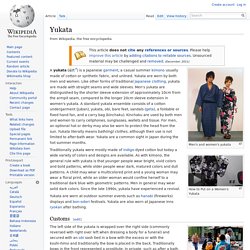
As with kimono, the general rule with yukata is that younger people wear bright, vivid colors and bold patterns, while older people wear dark, matured colors and dull patterns. A child may wear a multicolored print and a young woman may wear a floral print, while an older woman would confine herself to a traditional dark blue with geometric patterns. Men in general may wear solid dark colors. Keikogi. The top part of the keikogi is called the uwagi (uwa means "upper" and, again, "gi" means clothes).
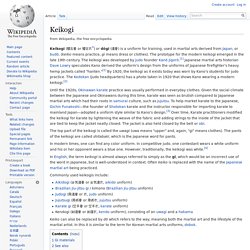
The pants of the keikogi are called shitabaki, which is the Japanese word for pants. In modern times, one can find any color uniform. In competitive judo, one contestant wears a white uniform and his or her opponent wears a blue one. Hakama. Hakama (袴?)

Are a type of traditional Japanese clothing. They were originally worn only by men, but today they are worn by both sexes. Hakama are tied at the waist and fall approximately to the ankles. Hakama are worn over a kimono (hakamashita)[citation needed]. Geta (footwear) Utagawa Toyokuni III (Kunisada)

Dhoti. For the far western region of Nepal, see Doti.

Pancha are commonly worn with western-style oxford shirts by Indian males. Sari. Woman and girl dressed in traditional Maharashtra sari The sari is usually worn over a petticoat (called 'parkar' (परकर) in Marathi lahaṅgā or lehenga in the north; pavadai in Tamil, pavada (or occasionally langa) in Malayalam, Kannada and Telugu, chaniyo, parkar, ghaghra, or ghagaro in the west; and shaya in eastern India), with a fitted upper garment commonly called a blouse (ravika in the south and choli elsewhere).
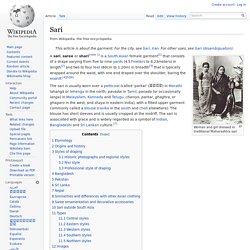
The blouse has short sleeves and is usually cropped at the midriff. The sari is associated with grace and is widely regarded as a symbol of Indian, Bangladeshi and Sri Lankan culture.[7] Etymology[edit] Origins and history[edit] The word sari is derived from Sanskrit शाटी śāṭī[8] which means 'strip of cloth'[9] and शाडी śāḍī or साडी sāḍī in Prakrit, and became sāṛī in Hindi.[10] The word 'Sattika' is mentioned as describing women's attire in ancient India in Buddhist Jain literature called Jatakas.[11] This could be equivalent to modern day 'Sari'.[11] Cheongsam. Traditional Chinese qipao clothing buttons The cheongsam (/ˈtʃiːɒŋˈsæm/,[1] /ˈtʃɒŋˈsæm/ or /ˈtʃɒŋˈsɑːm/) is a body-hugging one-piece Chinese dress for women, also known in Mandarin Chinese as qipao (旗袍; pronounced [t͡ɕʰǐ pʰɑ̌ʊ̯] Wade-Giles ch'i-p'ao), and Mandarin gown in English.
Hanfu. Hanfu (simplified Chinese: 汉服; traditional Chinese: 漢服; literally: "Han clothing"), also known as Hanzhuang (漢裝) or Huafu (華服), is the traditional dress of the Han Chinese people. The term Hanfu derives from the Book of Han, which says, "then many came to the Court to pay homage and were delighted at the clothing style of the Han [Chinese]. Clothing. Clothing in history, showing (from top) Egyptians, Ancient Greeks, Romans, Byzantines, Franks, and 13th- through 15th-century Europeans. Symbols of different types of materials for clothing: A) Woolmark B) Textile (Natural textile materials and Synthetic or non-woven textile materials) C) Leather D) Coated Leather E) Other Materials (All other materials including plastic, rubber, wood, paper, etc.)
Fashion. In Following the Fashion (1794), James Gillray caricatured a figure flattered by the short-bodiced gowns then in fashion, contrasting it with an imitator whose figure is not flattered. Fashion is a popular style or practice, especially in clothing, footwear, accessories, makeup, body piercing, or furniture. Fashion is a distinctive and often habitual trend in the style in which a person dresses. It is the prevailing styles in behaviour and the newest creations of textile designers.[1] Because the more technical term costume is regularly linked to the term "fashion", the use of the former has been relegated to special senses like fancy dress or masquerade wear, while "fashion" generally means clothing, including the study of it.
Although aspects of fashion can be feminine or masculine, some trends are androgynous.[2][3]